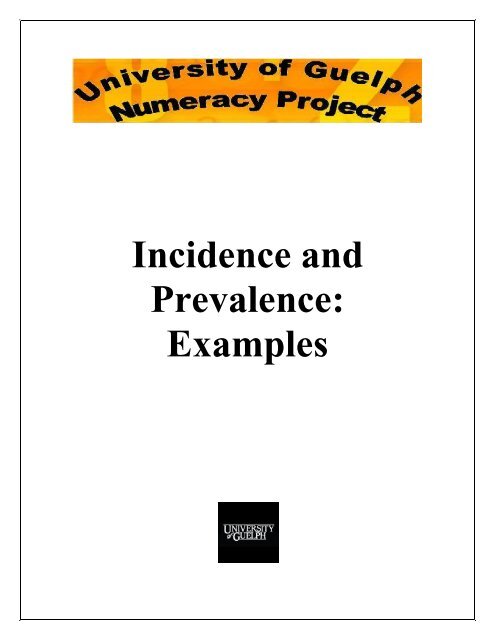Prevalence and Incidence Examples - Atrium
Prevalence and Incidence Examples - Atrium
Prevalence and Incidence Examples - Atrium
You also want an ePaper? Increase the reach of your titles
YUMPU automatically turns print PDFs into web optimized ePapers that Google loves.
<strong>Incidence</strong> <strong>and</strong><br />
<strong>Prevalence</strong>:<br />
<strong>Examples</strong>
TABLE OF CONTENTS<br />
<strong>Incidence</strong>/<strong>Incidence</strong> Rates .................................................................................................. 1<br />
<strong>Incidence</strong> Rates: Example............................................................................................... 1<br />
<strong>Incidence</strong> Rates: Another Example................................................................................. 1<br />
<strong>Prevalence</strong>/<strong>Prevalence</strong> Rates .............................................................................................. 2<br />
Example: Examining the <strong>Prevalence</strong> of Hypertension ................................................... 2
<strong>Incidence</strong> <strong>and</strong> <strong>Prevalence</strong>: <strong>Examples</strong><br />
<strong>Incidence</strong>/<strong>Incidence</strong> Rates<br />
<strong>Incidence</strong> Rates: Example<br />
► Consider Chicken Pox, where the cumulative incidence rate is 20<br />
percent per year, <strong>and</strong> 100 individuals are followed up. On average,<br />
after 6 months, 10 individuals will catch the disease.<br />
► In diseases that happen only once (as with Chicken Pox), the 10<br />
individuals having caught it are no longer considered to be "at risk."<br />
Therefore, the denominator is 100 at the start of the study, but the size<br />
of the "at risk" population will decrease thereafter. With studies such<br />
as these, where the first occurrence in an individual is the only one of<br />
interest, the denominator should be decremented by 1 for each case<br />
that occurs. In this case, the denominator would presumably be 95<br />
at the 3 month stage, 90 at the 6 month stage, etc.<br />
►<br />
Under these conditions, the denominator can be expected to decrease<br />
almost constantly. In order to account for this, incidence rates must be<br />
calculated for small time periods. Here, one might use the person-time<br />
incidence rate, as it allows a certain incidence rate to be investigated<br />
at a particular point in time. This property makes person-time<br />
incidence rates popular in cohort studies.<br />
<strong>Incidence</strong> Rates: Another Example<br />
►<br />
►<br />
Consider a cohort study with follow-up over 5 years which aims to<br />
discover the type of incidence rate that best investigates the risk of<br />
lung cancer within 50-70 year olds. Discuss the pros <strong>and</strong> cons of both<br />
approaches.<br />
Deciding which method to use rests almost solely in the type of study<br />
being conducted. If the cohort is being considered at a single point in<br />
time (e.g. all the individuals graduated from high school in the same<br />
year), the option is left open.<br />
1
►<br />
►<br />
For our example, we would recruit individuals within our target age<br />
group. The participants would be observed for a specified time period<br />
to document results. Here, either a cumulative incidence rate, or a<br />
person-time incidence rate could be used.<br />
Approaching this study realistically, however, subjects are not likely<br />
to be recruited all at once, but over a prolonged time period. As such,<br />
the cumulative incidence rate is not appropriate <strong>and</strong> the person-time<br />
incidence rate would be the better selection.<br />
<strong>Prevalence</strong>/<strong>Prevalence</strong> Rates<br />
Example: Examining the <strong>Prevalence</strong> of Hypertension<br />
►<br />
►<br />
►<br />
►<br />
First, the disease must be defined. For instance, the World Health<br />
Organization (WHO) defines hypertension to be 3 congruous<br />
measurements of blood pressure exceeding 140/90 mmHg. For your<br />
study population to meet this requirement, testing will be needed.<br />
Generally, blood pressure measurements can be easily obtained.<br />
Now, a suitable "at risk" population must be chosen. Often, it is hard<br />
to find an unbiased sample population for prevalence studies, unlike<br />
incidence studies. <strong>Incidence</strong> studies usually deal with instances such<br />
as death, while point prevalence studies typically consider survivors.<br />
Determining how long the study lasts relies solely on the type of study<br />
(point, period or lifetime prevalence). For the given example, the best<br />
selection would be period prevalence. Point prevalence can be<br />
excluded, as it may potentially provide a value unhelpful to<br />
organizations looking to create ways of dealing with the problem;<br />
whereas, lifetime prevalence can be ruled out because hypertension is<br />
typically a condition of old age.<br />
In the end, the onus is on the epidemiologist to come up with an<br />
appropriate course of action for researching the prevalence of a<br />
particular disease, as every case is different.<br />
2
















